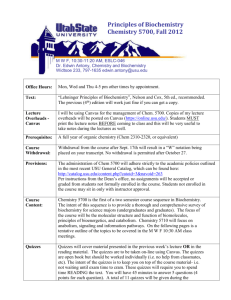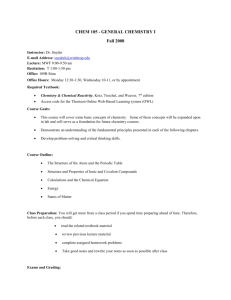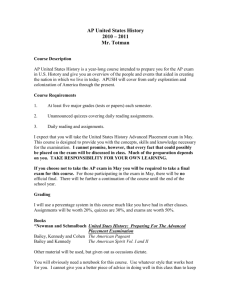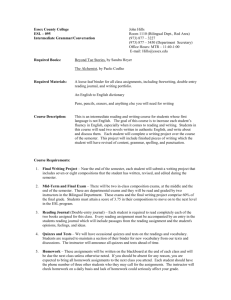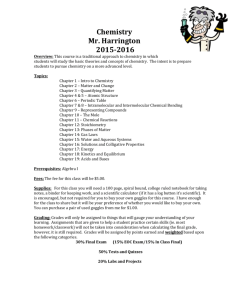CHEM 5700 - chem.usu.edu
advertisement
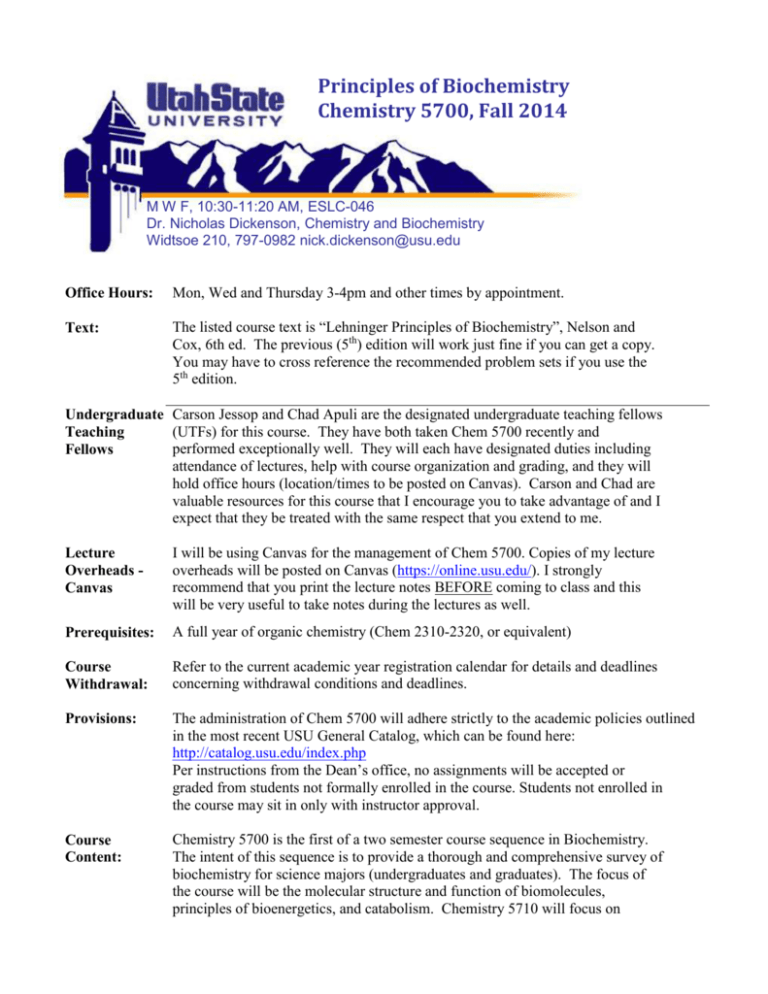
Principles of Biochemistry Chemistry 5700, Fall 2014 M W F, 10:30-11:20 AM, ESLC-046 Dr. Nicholas Dickenson, Chemistry and Biochemistry Widtsoe 210, 797-0982 nick.dickenson@usu.edu Office Hours: Mon, Wed and Thursday 3-4pm and other times by appointment. Text: The listed course text is “Lehninger Principles of Biochemistry”, Nelson and Cox, 6th ed. The previous (5th) edition will work just fine if you can get a copy. You may have to cross reference the recommended problem sets if you use the 5th edition. Undergraduate Carson Jessop and Chad Apuli are the designated undergraduate teaching fellows (UTFs) for this course. They have both taken Chem 5700 recently and Teaching performed exceptionally well. They will each have designated duties including Fellows attendance of lectures, help with course organization and grading, and they will hold office hours (location/times to be posted on Canvas). Carson and Chad are valuable resources for this course that I encourage you to take advantage of and I expect that they be treated with the same respect that you extend to me. Lecture Overheads Canvas I will be using Canvas for the management of Chem 5700. Copies of my lecture overheads will be posted on Canvas (https://online.usu.edu/). I strongly recommend that you print the lecture notes BEFORE coming to class and this will be very useful to take notes during the lectures as well. Prerequisites: A full year of organic chemistry (Chem 2310-2320, or equivalent) Course Withdrawal: Refer to the current academic year registration calendar for details and deadlines concerning withdrawal conditions and deadlines. Provisions: The administration of Chem 5700 will adhere strictly to the academic policies outlined in the most recent USU General Catalog, which can be found here: http://catalog.usu.edu/index.php Per instructions from the Dean’s office, no assignments will be accepted or graded from students not formally enrolled in the course. Students not enrolled in the course may sit in only with instructor approval. Course Content: Chemistry 5700 is the first of a two semester course sequence in Biochemistry. The intent of this sequence is to provide a thorough and comprehensive survey of biochemistry for science majors (undergraduates and graduates). The focus of the course will be the molecular structure and function of biomolecules, principles of bioenergetics, and catabolism. Chemistry 5710 will focus on Chemistry 5700, Fall, 2014 anabolism, signaling and information pathways. On the following pages is a tentative outline of the topics to be covered in the M W F 10:30 AM class meetings. This schedule is subject to change. Critical Thinking Problem sets: Critical thinking and creative problem solving are invaluable skills for scientists of all fields, including Biochemistry. Chem 5700 is an upper division course designed to arm you with the knowledge necessary to address technically challenging problems. Over the course of the semester we will work several in class critical thinking problem sets as practice and you will have 2 take home problem sets each worth 50 points. The goal of these assignments is to promote problem solving that requires you to put together what you have learned in order to effectively address a problem that you have not been directly exposed to previously. Much of what you need to answer them will come from lecture and the provided materials, however, it is most likely that you will also have to search online databases and read primary literature, etc. to complete the projects. The time/date that the assignments will be due will vary based on the difficulty of the assignment, but will be communicated prior to assigning the problem set. Late assignments will be deducted 10 points per day. In-class work: To help guide and evaluate in-class discussion and participation, I will on occasion provide worksheets or other materials to be completed during class. The main goal of these assignments is to engage the students in critically thinking about the topics being discussed. These assignments will be collected during class and cannot be made up or turned in late. So, while attendance is not mandatory, you must be present to have access to these worksheets. In the event of an “excused absence” you must notify the instructor prior to the absence and arrangements will be made. The total points for all of these in-class assignments will be 50 points and will not be tallied until the end of the semester. Quizzes: Quizzes will cover material presented in the previous week’s lecture OR in the reading material. The quizzes are to be taken on-line using Canvas. The quizzes are open book/open note but MUST be worked individually. The intent of the quizzes is to keep you on top of the course material- i.e. not waiting until exam time to cram. You will have 45 minutes to complete the quiz once it is initiated. A total of 12 quizzes worth 10 points each will be given during the semester. Each student will be allowed to drop the lowest two graded quizzes. Quizzes will be open up no less than 48 hours from the time that they are posted on Canvas. You are allowed to drop your two lowest quiz grades and for this reason, I will not re-open a quiz after the cutoff time under any circumstance. Exams: Three hourly exams (100 points each) will be given during class on the dates indicated on the course schedule. The comprehensive final exam will be worth 150 points. The first three exams will consist primarily of short answer, essay, and problem solving similar to the exams given in previous years. The comprehensive final exam will be primarily multiple choice and matching format, similar to the online quizzes. I strongly encourage you to work the past years exams as part of your exam preparation. Make-up exams will only be allowed for students that can demonstrate a documented birth or death in the 2 Chemistry 5700, Fall, 2014 family or a documented illness or presence at a scientific conference or interview. Family vacations do NOT qualify as a reasonable excuse. Recommended Problem sets: Recommended problem sets from the text book will be provided periodically for the students. Participation is 100% voluntary and the problems will not be graded. Solutions will, however be posted for these problems and it is highly recommended that all of the students work these problems carefully as many of them will resemble the style of questions on the exams. Course Assessment: Students in this class are expected to develop proficiency in the principles listed on the class schedule and the attached “Learning Objectives” list. Questions provided on midterms, quizzes, and your analysis of the problem sets will be used to assess your understanding of these principles. The formats to be used for assessment will include instructor-designed questions (essay, short answer, problem solving, multiple choice) and will cover material that is expected to be mastered by students taking the first semester of a two semester upper division biochemistry class. Please note that assessment is a tool used by the Department of Chemistry and Biochemistry to improve the quality of instruction and proficiency of our students. Your grade will be based on your performance on the assignments indicated above, some of which will be used for course assessment. Grading: **There will be NO EXTRA CREDIT awarded in this class. Critical Thinking Problem Sets…………………………………………..100 points In-class critical thinking worksheets………………………………….......50 points On-line quizzes (12, drop lowest two) …………………………………..100 points Three hourly exams ...................................................................................300 points Comprehensive Final exam .......................................................................150 points Total..........................................................................................................700 points In terms of final assignment of grades, you are guaranteed the following grades if your final class percentage lies within the indicated ranges. 100-90% A through A89.9-78% B+ though B77.9-68% C+ through C67.9-59% D+ through DBased on the overall class average at the END of the semester, the percentage cutoffs may be adjusted to be lower than those above at the instructor’s discretion. They will never, however, shift higher. Students with ADA-documented physical, sensory, emotional or medical impairments may be eligible for reasonable accommodations. Veterans may also be eligible for services. All accommodations are coordinated through the Disability Resource Center (DRC) in Room 101 of the University Inn, (435)797-2444. Please contact the DRC as early in the semester as possible. Alternate format materials (Braille, large print, digital, or audio) are available with advance notice. Day Date Lectur e M 8/25 1 Tentative Class schedule (Subject to change) Topic Chapter, Lehninger (6th ED) Introduction to the course 1 3 Quiz #1 Chemistry 5700, Fall, 2014 W 8/27 2 Water: properties, ionization, hydrophobic effects 2 F 8/29 3 Amino acids, peptides, and proteins 3 M 9/1 W 9/3 4 Protein Structure 3 F 9/5 5 Protein Structural Tools 3 M 9/8 6 Protein 2˚ Structure 4 W 9/10 7 Protein 3˚ and 4˚ Structure 4 F 9/12 8 M 9/15 9 W 9/17 F 9/19 M 9/22 W 9/24 11 Enzyme Function 6 F 9/26 12 Enzyme Kinetics - I 6 M 9/29 13 Enzyme Kinetics - II 6 W 10/1 14 Regulatory Enzymes 6 F 10/3 15 Carbohydrates 7 M 10/6 16 Polysaccharides 7 W 10/8 17 Nucleic Acids: DNA 8 F 10/10 18 Nucleic Acids: RNA 8 M 10/13 W 10/15 19 Lipids 10 R 10/16 20 Lipids and Metabolism *Note Thursday Class 10 Due 9/3 Labor Day (No Class) Protein Structure Determination, Folding and Prion Diseases Protein function: ligand binding; allostery; regulation #2 Due 9/15 4 5 #3 Due 9/22 Critical Thinking Problem Set #1 10 Protein function: molecular motors 5 Exam 1 in class: covers Lectures 1-10 #4 Due 9/29 #5 Due 10/06 #6 Due 10/13 Critical Thinking Problem Set #2 4 #7 Due 10/20 Chemistry 5700, Fall, 2014 F 10/17 No Class Fall Break (Meet Thursday) M 10/20 W 10/22 21 Biological Membranes 11 F 10/24 22 Membrane Transport – Ion Channels 11 M 10/27 23 Bioenergetics - I 13 W 10/28 24 Bioenergetics - II 13 F 10/31 25 Glycolysis 14 Exam 2 in class: covers Lectures 11-20 M 11/3 26 Metabolic Disorders 14 W 11/5 27 Metabolic Regulation - I 15 F 11/7 28 Metabolic Regulation - II 15 M 11/10 W 11/12 29 Citric Acid Cycle 16 F 11/14 30 Citric Acid Cycle and Physiology 16 M 11/17 W 11/19 31 Fatty Acids 17 F 11/21 32 Nitrogen Excretion 18 M 11/24 33 Urea Cycle 18 W 11/26 Thanksgiving Break (No Class) F 11/28 Thanksgiving Break (No Class) M 12/1 34 W 12/3 35 F 12/5 36 F 12/12 Critical Thinking Problem Set #3 #8 Due 11/3 #9 Due 11/10 #10 Due 11/17 Exam 3 in class: covers lectures 21-31 Amino Acid Oxidation #11 Due 12/1 18 Mitochondrial electron transfer and oxidative phosphorylation Mitochondrial electron transfer and oxidative phosphorylation (Cont) Final Exam(All Lectures)9:30-11:20AM 5 19 19 #12 Due 12/8 Chemistry 5700, Fall, 2014 EXPECTATIONS This is a 5000 level class and I thoroughly expect you not just to memorize the information, but be able to interpret and apply it to specific tasks that will be presented to you throughout the course (research problem sets). At the end of the course, my expectation is that you are aware of the connection between the subject material to your everyday lives. YOUR RESPONSIBILITIES Come to Class Prepared a) Download notes and look them over BEFORE class b) Be punctual, attend all classes, and finish the quizzes/problem sets on time. c) Read all the assigned material in the book and any additional information/papers handed to you. d) Think about the material learnt and apply it to real-life scenarios. This would be a perfect way to study for your exams. MY JOBS Come to Class Prepared a) Be precise and systematic with presentation of the lecture material. b) Be clear and fair about expectations. c) Provide you with ample material to best understand the concept being taught. d) Enable you to critically think and apply the concepts. OBJECTIVES In planning this course, I have identified three main course objectives: 1. Gaining factual knowledge (terminology, classifications, methods, trends) 2. Learning fundamental principles, generalizations, or theories 3. Learning to apply course materials (to improve rational thinking, problem solving and decisions) Below is a list of examples of how these objectives apply to material throughout the semester: A. Teach the fundamentals of biochemistry including the connection between chemistry, math, and biology and how it pertains to a quantitative description of life. Present the information about the building blocks of life protein, DNA, RNA. Teach the students how these molecules are synthesized, regulated, and specifically highlight how these processes are interconnected (1,2,3). B. Describe the concept of enzymes; including how they are made, how they function and the biological and biophysical processes that define their activity and function. Help the students connect the dots between how mutations in the DNA lead to defective enzymes and their disease phenotypes (1,2,3). C. Describe to students the connection between how the findings were uncovered, what is their historical context and where they encounter such information in their lives (diagnostic tests, etc.). (1,2,3). D. Teach how humans makes and use energy. What are the by-products of energy metabolism and how does the body secrete the waste. (1,2,3). 6

